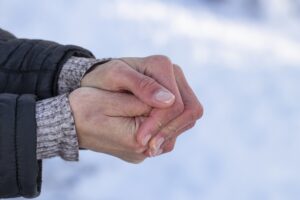 Fresh snow can be a calming and inviting atmosphere for a walk, but it can be more dangerous than it looks.
Fresh snow can be a calming and inviting atmosphere for a walk, but it can be more dangerous than it looks.
Fresh snow applies a blanket to potential hazards like steps, downed branches, and even ice, which can boost the risk of trips, slips, and falls. And if you go down, what do you do? Like most, you probably extend your hands and arms to break your fall.
Advertisement
And that response makes sense. Using these extremities to break your fall could help you avoid a more serious injury, like a broken hip or thigh. But using your hands to break a fall often leads to injury in the small, intricate bones in the hands and wrist.
Here are some ways to protect your hands and wrists from potential injury from walking on a lovely winter day.
The first is to stay alert and aware of your surroundings. Snow makes it easy to miss steps, for example, so do your best to walk in familiar areas and remember where there are steps, curbs, etc.
It is also a wise idea to clear the pathways and steps of your home as soon as you can.
Looking out for ice and black ice, in particular, can help prevent falls. Black ice makes surfaces look wet, and avoiding stepping in these areas is the best way to stay upright.
Focus on where you are going and observe what lies ahead. That may mean taking a break from the chat you’re having during your walk to put a little effort into your movements.
Avoid looking at a screen or texting during your walk.
Wearing appropriate footwear with good traction is important, too. A good set of winter boots and icers are essentials for people who enjoy snow walks.
Advertisement
If you have poor vision, make sure you wear your corrective lenses during your walk or walking aid. Also, use one if you have chronic health conditions or take medication that boosts the risk of falls.
You can further support yourself by doing strength training exercises, which can help with bone density, stability, and balance. Getting plenty of calcium and vitamin D can help, too.
Stay safe on your winter walks, and remember the potential dangers.
